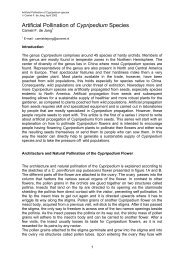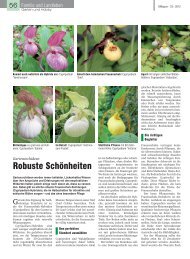Deflasking of Cypripedium seedlings - Cypripedium.de
Deflasking of Cypripedium seedlings - Cypripedium.de
Deflasking of Cypripedium seedlings - Cypripedium.de
Create successful ePaper yourself
Turn your PDF publications into a flip-book with our unique Google optimized e-Paper software.
How to raise in vitro propagated <strong>Cypripedium</strong> <strong>seedlings</strong> to fully established hardy plants for the gar<strong>de</strong>n<br />
© Camiel F. <strong>de</strong> Jong, December 2004<br />
used pure but should be used in mixes. Seramis retains too much water to be<br />
used on its own and Perlite on the other hand dries out too fast and does not<br />
retain nutrients.<br />
A mix that works well for me contains equal parts Seramis, Perlite and Vulca.<br />
However, since Seramis is quite expensive it may be omitted. As Perlite gives <strong>of</strong>f<br />
irritating dust, wear a dust mask during mixing <strong>of</strong> the substrates and wet them.<br />
The substrates that are used to plant newly <strong>de</strong>flasked <strong>seedlings</strong> in must be<br />
completely inorganic. Any organic material present in these mixes may promote<br />
Figure 2. Photographs <strong>of</strong> individual substrates <strong>of</strong> mixes used to <strong>de</strong>flask <strong>Cypripedium</strong> <strong>seedlings</strong>.<br />
The scale <strong>of</strong> the ruler is in centimeters.<br />
growth <strong>of</strong> molds and consequently loss <strong>of</strong> <strong>seedlings</strong>. However, there are two<br />
exceptions: C. acaule and C.arietinum. Seedlings <strong>of</strong> both species are planted out<br />
in a mix <strong>of</strong> equal parts coarse river sand and sphagnum peat. The C. arietinum<br />
<strong>seedlings</strong> seem to prefer more sand in the mix as compared to C. acaule<br />
<strong>seedlings</strong>. After planting the C. acaule <strong>seedlings</strong> MUST be watered with water to<br />
which vinegar 1 tablespoon (approximately 30 milliliters) <strong>of</strong> ci<strong>de</strong>r vinegar to 2 L <strong>of</strong><br />
water is ad<strong>de</strong>d to keep the substrate at low pH. To my knowledge, Scott Durkee<br />
<strong>of</strong> the Vermont Ladyslipper Company was the first to have acknowledged this. It<br />
is absolutely required for the survival <strong>of</strong> both C. acaule <strong>seedlings</strong> as well as<br />
mature plants. The plants in containers must be sheltered from rain as the rain<br />
washes out the acids in the substrate, yielding a pH above 4.5. In nature, C.<br />
acaule plants live in soils that are self sustaining acidic having a pH <strong>of</strong> around<br />
3.5. When the pH rises to above 4.5, water-soaked lesions <strong>de</strong>velop in the leaves<br />
due to pathogens that are subdued at low pH but get a chance at higher pH.<br />
4





